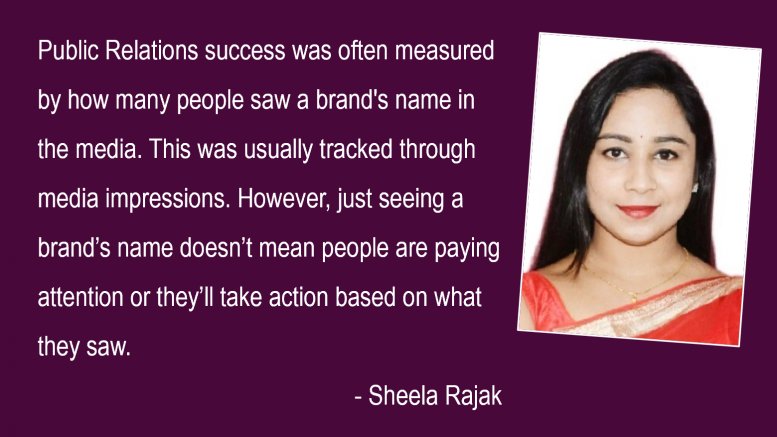Using Data to Measure Success and Create Personalised Communication
In today’s fast-paced world, public relations (PR) have evolved far beyond traditional methods of simply getting media coverage. While getting your brand’s name mentioned in the news or on social media was once seen as a big win, it’s no longer enough. Companies now want to know how PR efforts are affecting their business goals. This is where data-driven PR comes in—using data and analytics to measure success and create more personalised, effective communication.
With the help of data, PR teams can go beyond basic metrics like impressions (how many people saw a message) and focus on more meaningful results. These include things like audience engagement, how many people took action after hearing a message (conversion), and the overall sentiment toward the brand. At the same time, data is enabling brands to connect with their audiences in more personalised and targeted ways, ensuring that their messages speak directly to the right people. Let’s dive deeper into how data is changing PR strategies and the ways companies can use data to drive better results.
Moving Beyond Impressions: Measuring What Really Matters
In the past, PR success was often measured by how many people saw a brand’s name in the media. This was usually tracked through media impressions—the number of times a story appeared in the press or on social media. However, just seeing a brand’s name doesn’t mean people are paying attention, or that they’ll take action based on what they saw.
Today, with access to powerful data tools, PR professionals are shifting to metrics that give a clearer picture of how well a campaign is really performing. Instead of just tracking impressions, PR teams are looking at engagement, conversions, and brand sentiment to measure success:
- Engagement: This measures how people interact with content. For example, how many likes, shares, or comments a post gets on social media. The more people engage with a message, the more likely it is that the brand is building a meaningful connection with its audience.
- Conversions: Conversions track whether PR efforts lead to a specific action. This could be anything from a customer buying a product to signing up for a newsletter. It helps brands understand whether their PR activities are moving the needle on important business outcomes.
- Brand Sentiment: Brand sentiment looks at how people feel about a brand, whether it’s positive, negative, or neutral. By analysing social media posts, news articles, and customer feedback, PR teams can get a sense of whether the public’s perception is improving or declining. This helps companies adjust their messaging to make sure it’s resonating well with their audience.
By focusing on these deeper metrics, PR professionals can demonstrate how their efforts directly contribute to a brand’s success, and make smarter decisions about how to improve future campaigns.
Personalising PR Messages with Data
One of the most significant shifts in PR today is the ability to create personalised communication for different audience segments. Instead of using a broad, one-size-fits-all approach, companies are using data to craft tailored messages that speak to specific groups of people.
With the help of data, PR teams can segment audiences based on things like
- Demographics: Age, gender, location, income, job title, etc.
- Interests and Behaviours: What the audience likes, follows, or engages with online. This can include purchase history, browsing habits, and social media activity.
- Psychographics: Understanding people’s values, beliefs, and lifestyles to better connect with them.
For example, a fitness brand may send different messages to a 20-year-old college student who loves outdoor workouts compared to a 40-year-old professional looking for quick and efficient fitness routines. With this type of personalised communication, brands are much more likely to grab their audience’s attention and build a connection.
How Data Helps Tailor PR Campaigns
Once PR teams have segmented their audience, they can use data to personalise messages and deliver them through the right channels. Here are some examples of how data helps create more effective, tailored PR campaigns:
- Custom Press Releases: Rather than sending the same press release to every journalist, PR teams can personalise content based on the journalist’s beat (the topics they cover). For instance, a tech journalist might receive a release about innovative product features, while a lifestyle journalist could get one focused on how the product improves daily life.
- Social Media Content: Data tells PR teams which social media platforms their audience prefers and when they’re most active. For example, younger audiences may engage more on TikTok or Instagram, while professionals may spend more time on LinkedIn. By posting content that is tailored to the audience and the platform, PR teams can maximise engagement.
- Influencer Partnerships: Brands can use data to find influencers whose followers align with their target audience. By analysing an influencer’s demographics, engagement rates, and past campaign performance, PR teams can choose the right partner for the campaign, ensuring the message reaches the right people.
Real-Time Adjustments: Adapting Messages on the Fly
One of the biggest advantages of data in PR is the ability to monitor campaigns in real-time and adjust as needed. With data tools, PR professionals can track the performance of a campaign as it unfolds and make changes quickly if something isn’t working.
For example, if a PR campaign is getting a lot of social media engagement but not much press coverage, a PR team could adjust by pitching the story to more relevant journalists or media outlets. They might also shift the focus of their message to better align with what the audience is responding to. Real-time data allows for greater flexibility and the ability to make changes on the fly to maximise impact.
The Future of Data-Driven PR
As technology continues to advance, the role of data in PR is only going to grow. Artificial intelligence (AI) and machine learning (ML) are already being used to help PR teams predict trends, automate tasks, and gain even deeper insights into audience behaviour. These tools can make PR strategies even more targeted and effective by analysing large amounts of data and identifying patterns that humans might miss.
In addition, new technologies like chat bots and voice search are changing the way brands interact with their audiences. PR professionals will need to integrate these technologies into their campaigns to stay ahead of the curve and provide a seamless, personalised experience for their audience.
Conclusion
Data-driven PR is transforming the way companies approach public relations. By focusing on metrics like engagement, conversions, and brand sentiment, PR teams can measure the real impact of their efforts and show how PR contributes to business goals. At the same time, data enables brands to personalise their messages and connect with different audience segments in more meaningful ways. As the use of data in PR continues to grow, companies that embrace these strategies will be better positioned to build stronger relationships with their audience and deliver more effective PR campaigns.
The views and opinions published here belong to the author and do not necessarily reflect the views and opinions of the publisher.



Be the first to comment on "Smart PR: How Data Unlocks Personalised Engagement and Better ROI"